Beginnings of the Holodeck: AMD's DX11 GPU, Eyefinity and 6 Display Outputs
by Anand Lal Shimpi on September 10, 2009 2:30 PM EST- Posted in
- GPUs
Wanna see what 24.5 million pixels looks like?

That's six Dell 30" displays, each with an individual resolution of 2560 x 1600. The game is World of Warcraft and the man crouched in front of the setup is Carrell Killebrew, his name may sound familiar.
Driving all of this is AMD's next-generation GPU, which will be announced later this month. I didn't leave out any letters, there's a single GPU driving all of these panels. The actual resolution being rendered at is 7680 x 3200; WoW got over 80 fps with the details maxed. This is the successor to the RV770. We can't talk specs but at today's AMD press conference two details are public: 2.15 billion transistors and over 2.5 TFLOPs of performance. As expected, but nice to know regardless.
The technology being demonstrated here is called Eyefinity and it actually all started in notebooks.
Not Multi-Monitor, but Single Large Surface
DisplayPort is gaining popularity. It's a very simple interface and you can expect to see mini-DisplayPort on notebooks and desktops alike in the very near future. Apple was the first to embrace it but others will follow.
The OEMs asked AMD for six possible outputs for DisplayPort from their notebook GPUs: up to two internally for notebook panels, up to two externally for conncetors on the side of the notebook and up to two for use via a docking station. In order to fulfill these needs AMD had to build in 6 lanes of DisplayPort outputs into its GPUs, driven by a single display engine. A single display engine could drive any two outputs, similar to how graphics cards work today.
Eventually someone looked at all of the outputs and realized that without too much effort you could drive six displays off of a single card - you just needed more display engines on the chip. AMD's DX11 GPU family does just that.
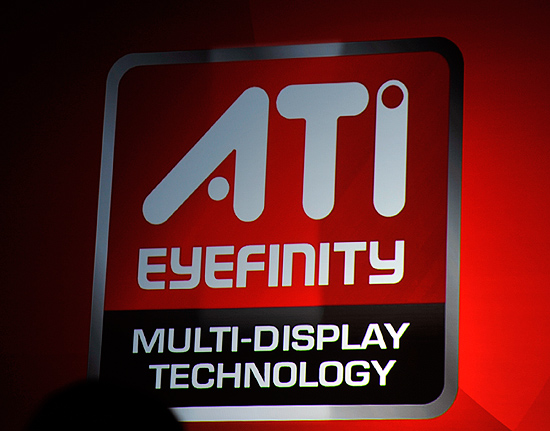
At the bare minimum, the lowest end AMD DX11 GPU can support up to 3 displays. At the high end? A single GPU will be able to drive up to 6 displays.

AMD's software makes the displays appear as one. This will work in Vista, Windows 7 as well as Linux.
The software layer makes it all seamless. The displays appear independent until you turn on SLS mode (Single Large Surface). When on, they'll appear to Windows and its applications as one large, high resolution display. There's no multimonitor mess to deal with, it just works. This is the way to do multi-monitor, both for work and games.
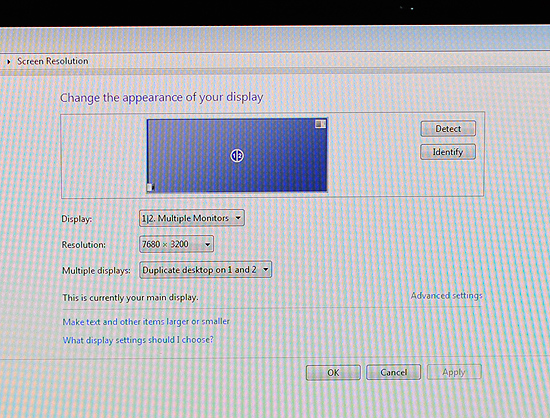
Note the desktop resolution of the 3x2 display setup
I played Dirt 2, a DX11 title at 7680 x 3200 and saw definitely playable frame rates. I played Left 4 Dead and the experience was much better. Obviously this new GPU is powerful, although I wouldn't expect it to run everything at super high frame rates at 7680 x 3200.
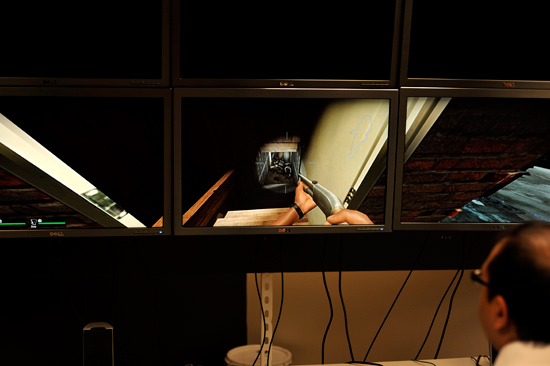
Left 4 Dead in a 3 monitor configuration, 7680 x 1600
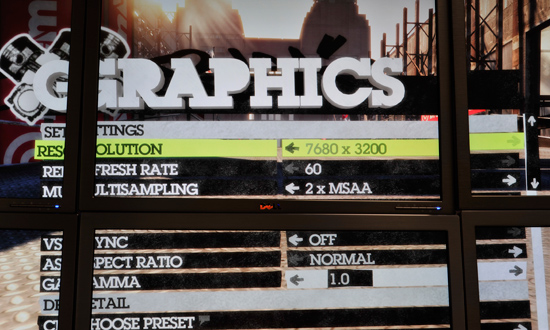
If a game pulls its resolution list from Windows, it'll work perfectly with Eyefinity.
With six 30" panels you're looking at several thousand dollars worth of displays. That was never the ultimate intention of Eyefinity, despite its overwhelming sweetness. Instead the idea was to provide gamers (and others in need of a single, high resolution display) the ability to piece together a display that offered more resolution and was more immersive than anything on the market today. The idea isn't to pick up six 30" displays but perhaps add a third 20" panel to your existing setup, or buy five $150 displays to build the ultimate gaming setup. Even using 1680 x 1050 displays in a 5x1 arrangement (ideal for first person shooters apparently, since you get a nice wrap around effect) still nets you a 8400 x 1050 display. If you want more vertical real estate, switch over to a 3x2 setup and then you're at 5040 x 2100. That's more resolution for less than most high end 30" panels.
![]()
Any configuration is supported, you can even group displays together. So you could turn a set of six displays into a group of 4 and a group of 2.
It all just seems to work, which is arguably the most impressive part of it all. AMD has partnered up with at least one display manufacturer to sell displays with thinner bezels and without distracting LEDs on the front:
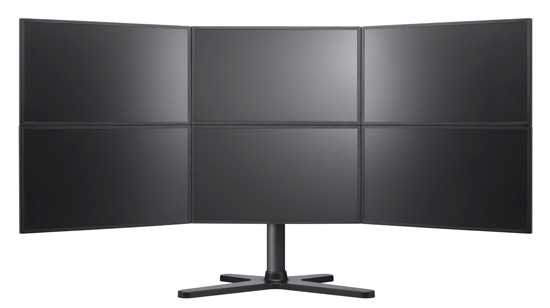
A render of what the Samsung Eyefinity optimized displays will look like
We can expect brackets and support from more monitor makers in the future. Building a wall of displays isn't exactly easy.










137 Comments
View All Comments
Myrandex - Friday, September 11, 2009 - link
I believe Matrox's Triple Head gaming was supposed to do this, and not just offer a wider resolution. I don't think it had much support, but I do think that Quake III was one title that did support it.Jason
Hlafordlaes - Thursday, September 10, 2009 - link
The setup reminds me of the Phillips Videowall technology of the 1980's. Consisted of a set of rear-projection monitors that could be individually addressed or spanned as one, with a barely visible seam between them that quickly became unnoticeable if you sat and watched a show.We set one up in a retail location, and since it coincided with the VHS boom at the time, we showcased new titles on it, which led to really high sales. Even Monserrat Caballé came to the shop to give a short recital "broadcast" on site. (And, yes, once one disgruntled employee managed to put a truly nasty sex tape on at peak shopping hours). I tell you, we wowed the rubes. But it was mega-$$$a the time.
The Samsung concept display shown in the article looks attractive, and a first step toward getting it right. One can see IMax+3D home theaters in the offing in a few years.
Flyboy27 - Thursday, September 10, 2009 - link
Dude...! $%&* Crysis!Seriously, its not THAT good. Ok for the people that always ask. From now on, yes it will run Crysis, and no you shouldn't give a $%&*.
Pirks - Thursday, September 10, 2009 - link
I doubt it will render Crysis faster than 1 frame per second. Good luck enjoying your focking slideshow :)JimmiG - Thursday, September 10, 2009 - link
Blurry textures, blocky models, leafs and vegetation made out of 2D sprites, and overly shiny, plastic, artificial looking trees and rocks will still look as crappy at 50 megapixels as they do at 1.8 Mp.Especially when combined with cramped levels, repetitive gameplay, dumb AI and a completely non-interactive environment (being able to blow everything to pieces doesn't count).
Pirks - Thursday, September 10, 2009 - link
It'll be 10 or 20 years till they could render Crysis with that 7000x3000 resolution with playable framerates*yawns*
Maybe my son lives long enough to see it... I hope
Griswold - Friday, September 11, 2009 - link
"Maybe my son lives long enough to see it... I hope"I hope you're kidding and not actually breeding...
Pirks - Friday, September 11, 2009 - link
I'll teach him how to taunt you too :Psbuckler - Thursday, September 10, 2009 - link
Well not quite but a lot more advanced then what ati is talking about. It's called a cave. You sit in a large cube, every wall of which has 2 projectors back projecting on to it. Put on the 3d glasses it's like the holo deck in that everything is in 3d and surrounds you.It's used for things like styling cars - designers can make the inside of a new car in cad then sit inside it too see if it really works.
Costs a fortune however and wouldn't fit in the average house :)
jay401 - Thursday, September 10, 2009 - link
It's cool and all, but it makes it like you're playing all your games through a football (gridiron) helmet due to the edges of the monitors intersecting the display.Also, unless you use one of the far right-side monitors as your primary desktop, you'll have that annoying run-off problem with the mouse cursor where it slides over to the display to the right when you just want to click the [X] for the window in your current monitor, just due to our ingrained nature of over-sliding the mouse to the upper-right corner when we want to close a window. :)
Using a left-side monitor as my primary, I can solve this with UltraMon by making my second display not only to the right but LOWER than my primary display, so that the cursor still stops at the upper right edge of my primary display.
I wonder how this system will handle it. Perhaps it will be smart enough or have a setting that allows you to keep the cursor from sliding beyond the right edge of the current screen when a program is maximized on that screen, so that you can hit the [X] easily like you can on a single display setup (or a right-side display in a multi-display setup).